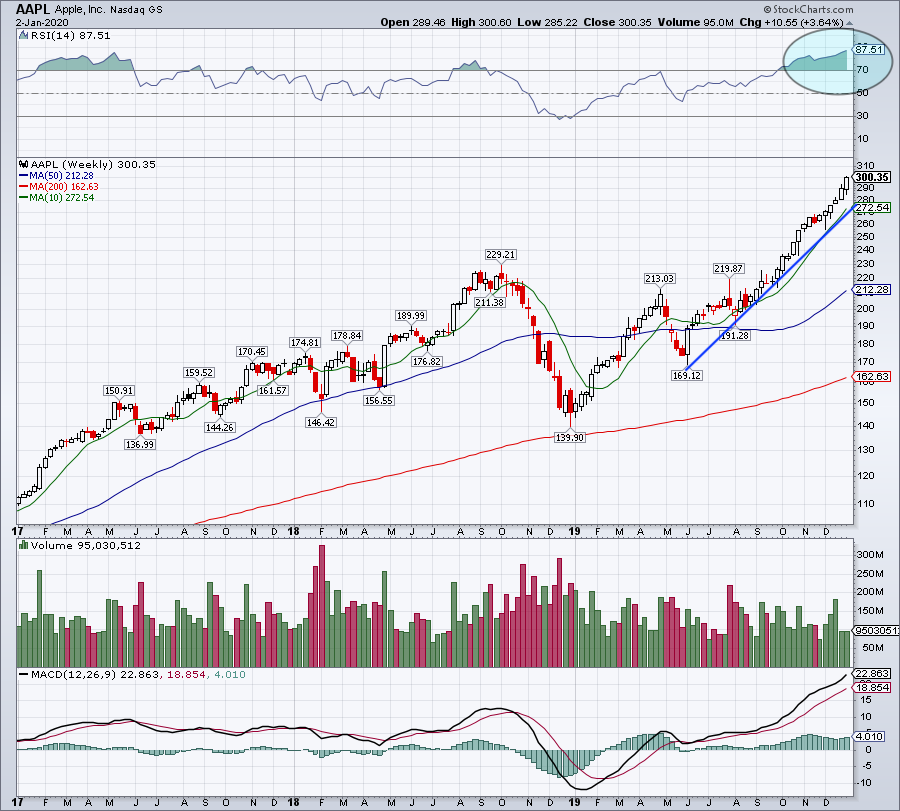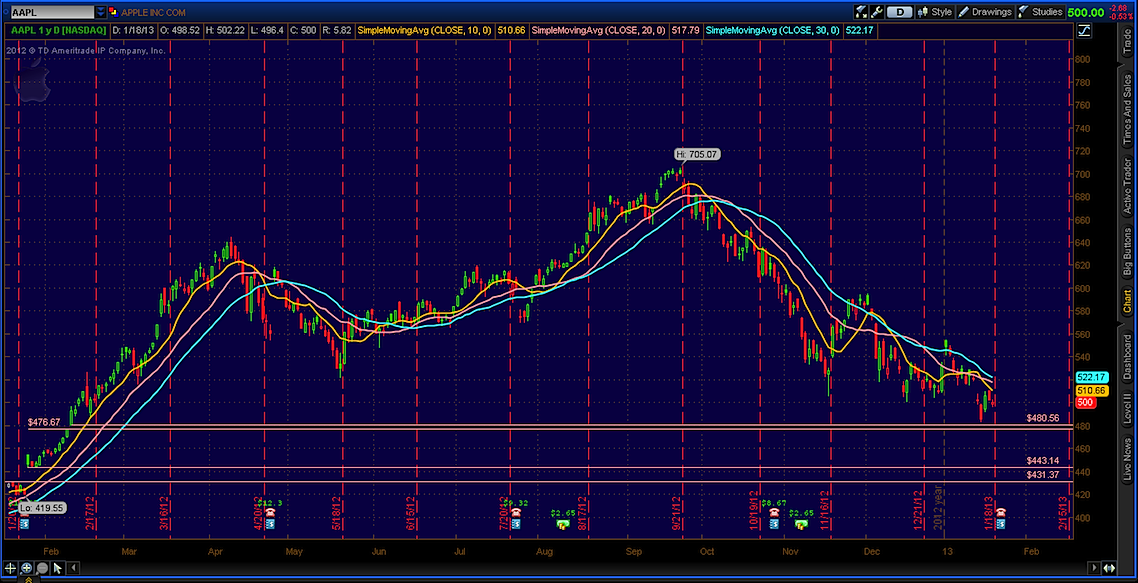Have you ever dreamt of riding the wave of Apple’s stock price, but felt hesitant about the risks of traditional stock investing? There’s a powerful tool in the financial world that can amplify your potential gains while also offering the flexibility to manage risk: Apple options.

Image: investorplace.com
Options trading might sound complicated, but with a bit of understanding, it can open doors to a world of strategic investment opportunities. Apple options, in particular, have a unique appeal due to the company’s massive market capitalization, loyal customer base, and constant innovation. This guide aims to demystify the world of Apple options, equipping you with the knowledge to confidently navigate this exciting market.
Understanding the Basics of Options
At their core, options are contracts that give the buyer the right, but not the obligation, to buy (call option) or sell (put option) an underlying asset at a predetermined price (strike price) on or before a specific date (expiration date). Imagine it like a ticket that grants you the option to buy a movie ticket at a discount, but you’re not obligated to use it.
Call Options
A call option gives you the right to purchase a stock at a specific price. Imagine you buy a call option for Apple stock with a strike price of $170 and an expiration date in three months. If Apple’s stock price climbs above $170 before the expiration date, you can exercise your option and purchase the stock at $170, even though the market price may be higher. You can then sell the stock for a profit, essentially locking in the difference. However, if the price stays below $170, the option will expire worthless, and you will lose your initial investment in the option.
Put Options
A put option grants you the right to sell a stock at a specific price. Let’s say you purchase a put option for Apple stock with a strike price of $160 and an expiration date in three months. If Apple’s stock price drops below $160, you can exercise your option and sell the stock at $160, despite its lower market price. This lets you profit from a decline in the stock price. However, if the stock price remains above $160, the option expires worthless, and you lose your investment.

Image: www.seeitmarket.com
Why Apple Options?
Apple options offer several compelling reasons for both seasoned investors and those new to options trading:
- High Liquidity: Due to Apple’s immense popularity and trading volume, options on Apple stock are highly liquid, making it easy to buy and sell them quickly with minimal slippage.
- Wide Range of Strike Prices and Expiration Dates: This versatility allows you to fine-tune your trading strategy and choose options that align with your risk tolerance and investment horizon.
- Potential for High Rewards: Options leverage allows you to control a large amount of underlying stock with a relatively small investment. This can lead to amplified returns if the stock price moves in your favor.
- Flexibility to Manage Risk: Options offer a range of strategies to mitigate risk, including selling options for income or using options to hedge existing stock holdings.
Unveiling the Benefits of Apple Options Trading
Apple options, as a powerful tool for strategic investing, offer a multitude of benefits:
Amplified Returns
Options trading allows you to control a much larger number of Apple shares than you could with just buying the stock outright, due to the leverage inherent in options contracts. This means that even a small price movement in your favor can lead to a significant profit. For example, if you purchase a call option for 100 shares of Apple stock with a strike price of $170 and the stock price rises to $180 within the next three months, your potential gain on the option could be much larger than if you simply owned 100 shares of Apple stock.
Risk Management
Options contracts provide inherent limit to your risk. The maximum amount you can lose is the premium paid for the option. So, while you can make a significant profit, your potential loss is capped. This allows for a higher level of control over risk compared to outright stock ownership. For instance, if you own 100 shares of Apple stock, you have unlimited downside risk, meaning you could potentially lose the entire investment.
Strategic Flexibility
Options give you a wide range of strategies to achieve your investment goals. You can buy options, sell options, or use a combination of these strategies to fine-tune your risk appetite and potential reward. For example, you could sell covered calls to generate income on your existing Apple shares, or you could use put options to protect against a drop in the stock price.
Navigating the Complexities of Apple Options Trading
While options trading can offer substantial potential, it is crucial to acknowledge the inherent complexities:
Volatility
Options prices are heavily influenced by the volatility of the underlying stock. Higher volatility means options prices tend to fluctuate more widely. This can lead to significant price swings, making options trading more challenging. Therefore, it is important to carefully analyze volatility dynamics when making option trading decisions, as this is a key factor driving their price fluctuations.
Time Decay
Options have a limited lifespan, meaning their value gradually decreases as they approach their expiration date. This phenomenon, known as time decay, affects both call and put options. As time passes, the likelihood of the stock price reaching a target level diminishes, leading to a decrease in the option’s value. Hence, it is essential to consider the remaining time until expiration when evaluating options, as time decay can significantly impact their profitability.
Understanding Greeks
To analyze and predict option price movements, traders often rely on a set of key factors known as “Greeks”. These include delta, gamma, theta, and vega, which represent the sensitivity of an option’s price to changes in underlying stock price, time, volatility, and interest rates. Grasping these Greeks can help you make more informed decisions by assessing the impact of various market factors on option values.
Strategies for Successful Apple Options Trading
There are numerous strategies for trading Apple options, each with its own risk and reward profile. Here are some common approaches:
Covered Call Writing
This strategy involves selling call options on Apple stock that you already own (covered). This allows you to earn premium income, providing extra cash flow on your Apple shares. However, you limit your potential upside profit, as you cannot benefit from any price increase above the strike price. In essence, you’re trading potential upside profit for premium income, making it suited for those who hold a long-term positive outlook on Apple, but wish to supplement their returns.
Protective Put Buying
This strategy involves buying put options on Apple stock to protect against potential losses in your stock holdings. This strategy essentially provides insurance against a decline in Apple’s stock price. While it does limit upside potential, it also limits downside risk, making it an excellent option for investors who want to protect their portfolio from market volatility.
Straddle
This strategy involves buying both a call and put option with the same strike price and expiration date. This allows you to profit from significant price movements in either direction, while minimizing potential losses. It can be beneficial during periods of high market volatility. However, this strategy can also be expensive due to the simultaneous purchase of both call and put options. This approach requires careful consideration of potential payoff scenarios and potential losses.
Strangle
This strategy involves buying both a call and put option with different strike prices, usually with the put option having a lower strike price than the call option. Similar to a straddle, this strategy allows you to profit from significant price movements in either direction. However, the strangle typically has lower premiums than a straddle, making it a less expensive strategy. Nevertheless, it also has lower potential profits compared to a straddle. Understanding the relative payoff structure is crucial for successful application of this strategy.
Aapl Options Trading
Key Takeaways and Considerations
Apple options trading can be a powerful strategy for investors looking to amplify their returns and manage risk. Here are some essential takeaways:
- Thorough Research: Understanding the basics of options trading, Apple’s fundamentals, and the market environment is critical for successful trading.
- Risk Management: Always prioritize risk management by only trading with capital you can afford to lose and utilizing strategies that align with your risk tolerance.
- Continuous Learning: The options market is constantly evolving, so it’s crucial to stay updated on new strategies, tools, and market trends.
- Consult with a Financial Advisor: If you are new to options trading, seek guidance from a qualified financial advisor who can help you develop a personalized strategy.
This guide has offered a glimpse into the world of Apple options trading. Remember, success in this field requires diligent research, responsible risk management, and continuous learning. By embracing these principles, you can unlock the potential of Apple options for your investment journey.






